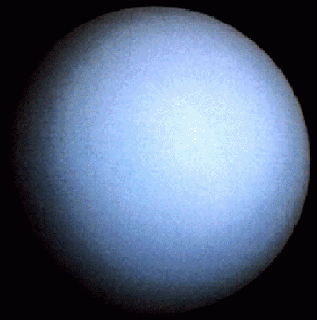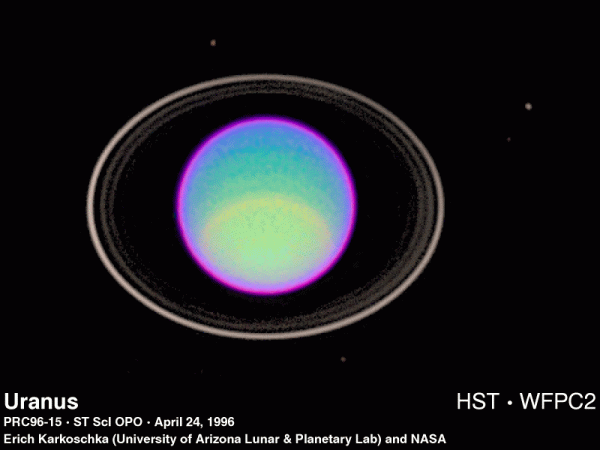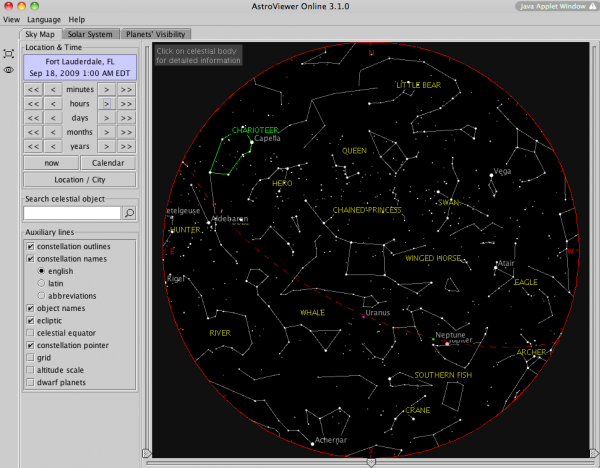William Herschel‘s planet, Uranus, which sounds remotely repulsive whether you pronounce it the right way (URINE-us) or the wrong way (yer-ANUS), is at opposition today. Wouldn’t it have been nicer if they’d transcribed the Greek in a more appropriate phonetic style as Ouranos? Then we wouldn’t have so many schoolboy jokes about this planet. There. Now, having established my anti-schoolboy street cred, I can go on to explain that I am talking about astronomical opposition, not some sort of Jungian midlife crisis thing. (Were I copyediting my own copy, I would strike the extraneous “thing” in that last sentence. But I’m not going to kill my own joy that way. Wait a minute. Does the fact that I’m pursuing my own pleasures in self-expression by not censoring myself mean that I am entering a second childhood. Already? Maybe this is a midlife crisis thing.)
A few statistics: Uranus is the penultimate (i.e., seventh) planet from our Sun. At 2.8 x 109 km distance, its orbit around the Sun takes 84 Earth years. Like its larger, closer cousins, Jupiter (orbital period 12 years) and Saturn (orbital period ~29.5 years), Uranus has rings. Unlike them and all the other planets in our solar system, though, its axis of rotation is nearly perpendicular to the ecliptic plane, presumably as a result of a collision with an Earth-sized body in the past. This peculiar orientation makes seasons on Uranus rather interesting, although slow to evolve. Each season takes about 20 of our Earth years, and they progress from pole to equator to pole, unlike the situation on Earth, where we have a tropic zone that has no astronomically-related seasons.
Uranus also has rings, as seen here through the Hubble Space Telescope in 1995:
The rings, like Jupiter’s, are pretty much invisible from Earth, although they are detectable at particularly favorable occultations of stars, as happened in 1977.
Uranus was discovered, if that’s the word for it, in 1781 by one of the greatest observational astronomers of his, and any, time: William Herschel. The discovery is actually a sequence of events, as many astronomical discoveries are: observation, misunderstanding, insight, correct understanding. In the case of Uranus, the person who first observed it was by no means its discoverer; it had been seen and (mis)catalogued dozens of times before 13 March 1781, when Herschel trained his telescope on the stars near H Geminorum–and Herschel didn’t know what it was when he found it, although he was sure what it was not: a star! (So it makes sense that the name he would propose for it, Georgium Sidus, means George’s star!)
The Greeks probably had been able to see Uranus; it’s a 6th magnitude object, so it is visible, if nowhere near as bright as the other planets, in our night sky. John Flamsteed, the royal astronomer, observed it on at least 6 separate occasions in 1690,1712, and 1715 (Price, Planet Observer’s Handbook, 321) but because of its slow movement and his smallish telescope which didn’t enable him to see, or observe, its disk, he cataloged it in the Historia coelestis Britannica, as a star, 34 Tauri. The star didn’t make it into the 1753 edition of the Atlas Coelestis, though. At least, I can’t find it on the Taurus plate; maybe you can?
Another near-discoverer of the planet was Pierre Charles Le Monnier, who, according to Price, “had recorded the position of the planet on four consecutive nights and two more times within nine days. These six ‘stars’ were actually the one moving planet. Unfortunately, Le Monnier did not compare his observations; if he had done so, Uranus would have been discovered 12 years earlier in 1769.”
It took Herschel’s homemade 6.2-inch reflector with a seven foot focal length (typical for the time) to see that the object had an extended disc, and was therefore not a star. Here is how he described the observation in a letter read to the Royal Society on April 26, 1781:
On Tuesday the 13th of March, between ten and eleven in the evening, while I was examining the small stars in the neighbourhood of H Geminorum, I perceived one that appeared visibly larger than the rest: being struck with its uncommon magnitude, I compared it to H Geminorum and the small star in the quartile between Auriga and Gemini, and finding it so much larger than either of them, suspected it to be a comet. (Bakich, Cambridge Planetary Handbook, 264)
There are at least two reasons why Herschel, an amateur astronomer–excellent, but amateur– would have assumed he had discovered a comet rather than a planet. (As you can imagine, I have nothing against amateurs, being one myself!)
- Everyone knows (or they did at the time, anyway) that there are only 6 planets*, and since we’re on one of them, there were only 5 to see in the sky: Mercury, Venus, (Earth, which doesn’t count), Mars, Jupiter, and Saturn. No one, in the entire history of the world, had ever discovered a planet. Comets, on the other hand, were quite a bit more common.
- As Herschel increased the magnification of his 7-foot (focal length, not aperture) telescope, the disc of the object appeared to increase in diameter. Further “proof” of its nature as a comet came 4 days later, when he checked its position, and it had moved.
When Herschel reported his new comet to the professionals (in this case, the astronomer royal, Nevil Maskelyne), they repeated his observations and were not convinced that it could be a comet. Maskelyne’s reply to Herschel called the discovery a “comet or new planet,” language he repeated in a letter to the German astronomer Johann Elert Bode, director of the Berlin Observatory. Bode took a longer series of observations which proved the orbit to be planetary rather than cometary. [Bode even suggested the name for the new object: Uranus, which makes sense because, as “Saturn was the father of Jupiter, so the next planet out should be the father of Saturn” (Bakich 266).]
Herschel himself, however, tired of being a musician in Bath, and perhaps seeking royal patronage, decided that George was a lovely name for the new planet. Georgium Sidus, to be precise. George III, King of England at the time, thought it a lovely name as well, and rewarded the former organist turned telescope maker with a royal stipend, on condition that he move closer to Windsor, the better to be able to share his views of the heavens with the royal family. It wasn’t until 1822 that the planet’s name was settled as Uranus. [As you can imagine, non-British astronomers weren’t too excited to call the planet after the King of England; they tended to call it Herschel, after its discoverer (Bakich, 267).]
Tonight, if you’re looking for George’s Star, you can’t do better than go outside at midnight (1 a.m. for those of you who live on daylight saving time) and look at the edge of the constellation Pisces, near the border with Aquarius. Remember, though, it’s nothing but a dim star to the naked eye (and to the telescopes of Flamsteed’s day). It’s also not very spectacular through the amateur telescope, to those used to seeing Jupiter and Saturn. If you want a map, try your favorite astronomy application (Google Earth works fairly well for this purpose), or use this one that I found online called Astroviewer:
Hope you have fun!
*Until a few years ago, everyone knew that there were nine. Now there are only 8…





2 thoughts on “Uranus at opposition tonight”